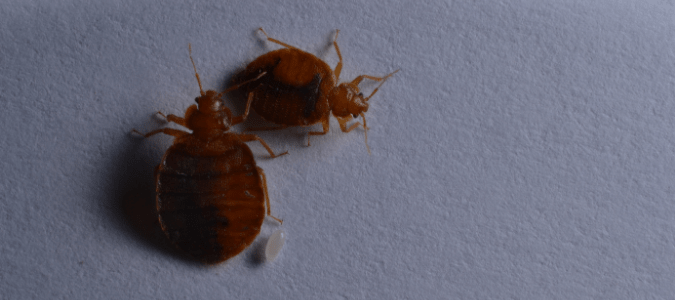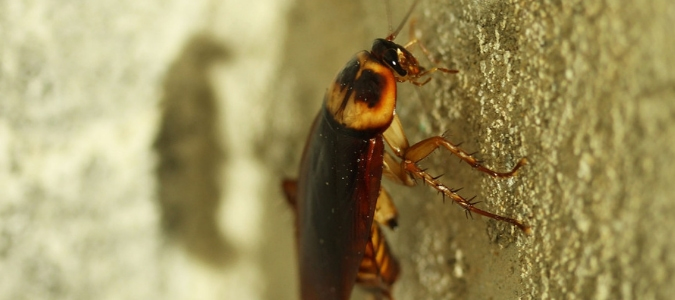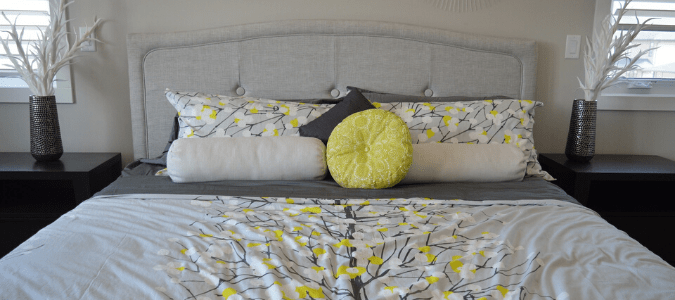If you have found a bed bug or you’re experiencing the signs of a bed bug problem, you likely have plenty of questions. Like, how fast do bed bugs multiply? The good news is that they don’t reproduce as quickly as some other pests do. Bed bugs only lay one or two eggs a day. The bad news is that it can be difficult to catch a bed bug problem early. And, once a bed bug infestation is established, it is incredibly hard to get rid of.
Bed bugs are tiny and excellent at hiding. Lots of times, when bed bugs reproduce, they do so in unexpected places—not just in a bed or mattress, as their name suggests. These pests may nest behind baseboards, hanging picture frames or loose wallpaper. They might hide and nest in drawers, between cushions or floorboards, or even in tiny cracks in walls.
So, how can you confirm that you do, in fact, have a bed bug problem?
Identifying a Bed Bug Problem
An adult bed bug is a brown, oval-shaped insect no more than a quarter-inch long. Its body is so flat that it can hide in narrow cracks where only a credit card would fit. Bed bug eggs are almost as small as grains of sand. They are even harder to spot than adult bed bugs, unless you know exactly where to look and what you’re looking for. The same goes for bed bug babies (also known as nymphs). Bed bugs in this stage of the life cycle get larger as they molt (shed their skins), but they are very small and paler in color than adults, so they can be hard to see.
Bed bugs are most active at night, which is when they can move around without being seen to get the blood meal they depend on to live. You may find bed bug bites the next morning, or within the next few days, in lines of small, reddish bumps on the skin.
Most bed bug bites will show up on exposed skin. Bed bugs don’t usually burrow under clothes or covers to get their blood meals. Instead, they bite skin that is easily accessible, like people’s arms, feet, faces and necks. For most people, bed bug bites are intensely itchy. They might even turn into small blisters.
Bed bug bites are often the main sign people notice indicating they have a bed bug problem. If you think you might have bed bugs, you can look for these other telltale signs.
Where To Look for Bed Bugs and What To Look For
The first place to check is your bed. Look for small black or rust-colored dots and streaks on your sheets, pillows and mattress. These are stains from dried blood and bed bug feces. You might also check for shed bed bug skins along the seams of your mattress or along the piping on cushions. Bed bugs don’t infest only beds, after all. They can infest any furniture where people spend lots of time, including sofas and easy chairs. Some people wrap tape, sticky side out, around a credit card and press it into these small spaces. Then, they pull the card out to check for any bed bugs or shed skins that got stuck to the tape. This is one way to check for the presence of bed bugs.
If you do have a bed bug problem in your home, it’s not a sign that your house is filthy! Bed bugs are opportunistic, which means they will infest any home where they can get a blood meal. If you have traveled recently or brought second-hand items into your home, that could be the source of your bed bug problem.
Many people wonder if one room has bed bugs, does that mean all rooms have bed bugs? Once bed bugs are established in one room of the home, they can be transported to other rooms. This is can happen when you move blankets, pillows or furniture from a bed bug infested room into another room. That’s why it’s sometimes necessary to treat the entire house instead of the one main room where the pests were found.
What To Do About Bed Bugs
Unfortunately, do-it-yourself methods for controlling bed bugs typically aren’t very effective. These pests are extremely difficult to get rid of. If you do have bed bugs, there are things you can do to help prevent their spreading from room to room. Washing and drying bedding on the hottest setting possible, for example, will help kill off bed bugs in all stages of the life cycle. It’s also important not to move furniture from one room to another, so you don’t introduce bed bugs to other areas of the house.
You can store clean, bed-bug-free clothes, sheets, pillows and other bedding in plastic garbage bags while your home is being treated. Once your bed has been de-bugged, you can also encase your mattress in plastic to keep bed bugs away in the future. If your bed bug infestation is so extensive that you have to get rid of your mattress or other furniture, be sure to spray paint “BED BUGS” on it or slash it with a utility knife before putting it outside. This way other people won’t find it and bring it into their own homes.
If you find signs of bed bugs, your best bet is to hire a bed bug specialist to inspect your home and then recommend a treatment plan. These pest control professionals know where to look for signs of bed bugs and what to look for. They have access to the most advanced products, techniques and technologies needed to address the pest problem.
Sometimes people don’t treat pest problems in their homes because they think one pest might provide natural control for some other, even worse type of pest. This is the kind of thinking that leads some people to ask if cockroaches could provide natural pest control against bed bugs.
Do Roaches Eat Bed Bugs?
Do roaches eat bed bugs? The short answer is yes. Cockroaches will eat bed bugs in all stages of their life cycle, including bed bug eggs. But, they should not be relied on for pest control.
Roaches can’t consume nearly enough bed bugs to get an infestation under control. Plus, of course, the fact that roaches are pests, themselves. Furthermore, bed bugs and roaches often infest separate areas of the house. Roaches are most often found in the kitchen and bathrooms, while bed bugs are more likely to be in the bedrooms.
If you have both roaches and bed bugs in your home, it’s best to contact a pest control professional. A pro can inspect your home and treat both pest problems. Roaches can carry disease and create unsanitary conditions. They can even cause health problems like asthma and allergies. Bed bugs don’t carry diseases that affect humans, but their bites are incredibly itchy. Too much scratching can lead to serious secondary infections like staph and MRSA. Both of these pests need to be treated for, especially if they have infested a home.
Bed bugs are very good at hiding, which makes it really hard for most people to know where to look for signs of bed bugs, or even what to look for. This is part of the reason why it’s so hard to get rid of bed bugs on your own. It is also why the process of dealing with these pests is often very emotional and anxiety-inducing for so many people. This is another area where a pest control professional can help. They can identify the type and scope of your pest problem. Then, they can determine the fastest and most effective methods for getting rid of it.
How Do Exterminators Get Rid of Bed Bugs?
If you have a bed bug problem, you’re probably wondering, “How do exterminators get rid of bed bugs?” Treating bed bugs is best approached in a customized way. That being said, the most common professional bed bug treatment methods include:
- Heating the whole home to 130 degrees Fahrenheit for four hours. This will ensure that all adult bed bugs, eggs and nymphs have been eliminated.
- Treating the infested room and furniture with various types of insecticide products. This might include dust insecticides for cracks as well as contact insecticides for surfaces that people touch.
Homeowners can take several different steps to support professional bed bug treatments, such as:
- Clearing away clutter from the infested area or room, so the professional treatment can reach as many bed bugs and be as effective as possible.
- If items like toys, stuffed animals, clothing or bedding might be harboring bed bugs or their eggs, they can be sealed inside plastic bags or heated in the dryer on high heat for at least 30 minutes.
- Wash bed bug infested bedding and clothes and then dry them on the hottest dryer setting.
- Vacuum your mattress, paying special attention to the seams and edges where bed bugs might hide or lay eggs. Once that’s done, encase your mattress in plastic to kill off any other hiding bed bugs and protect the mattress from future infestations.
- Vacuum around the bed, including the bed frame, the floor, the baseboards and the walls.
- Taking the bed frame apart, if possible, is also a good idea, so you can inspect it thoroughly for bed bugs and their eggs.
- Get rid of bed bugs in your couch and other furniture by moving it away from the walls, and emptying out dresser drawers. Vacuum inside the drawers and underneath and behind all furniture.
- Use caulk to seal off any cracks in wall plaster or between baseboards and the wall, so bed bugs can’t hide or reproduce there.
Hiring a professional is a must when it comes to an active bed bug infestation. You and your bed bug specialist can work together to get rid of these pests, so you and your family can be comfortable again.
ABC Can Make You and Your Family Members Comfortable
Don’t waste your time with home remedies. Get relief from bed bugs by contacting ABC Home & Commercial Services. We create customized pest treatment plans that will work best for you and your family members, so your life can get back to normal.



